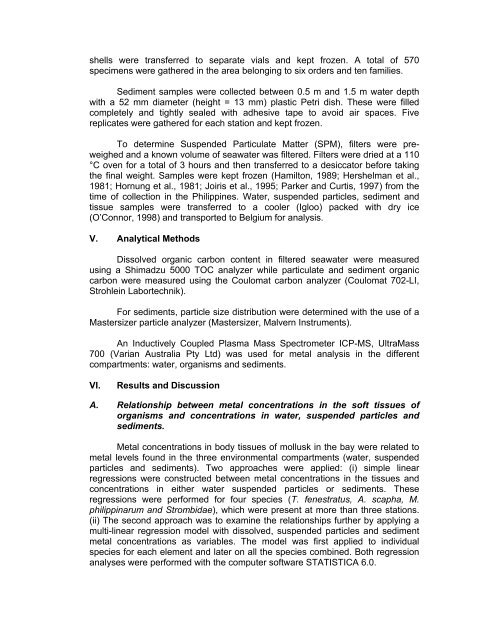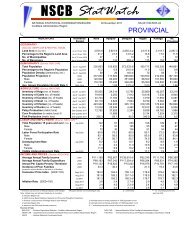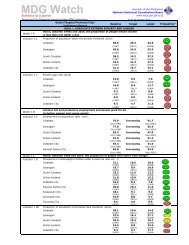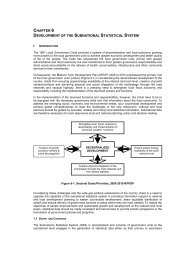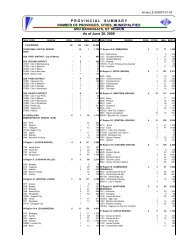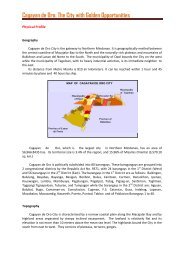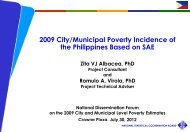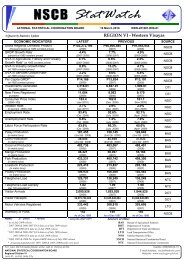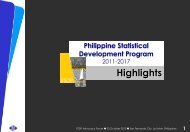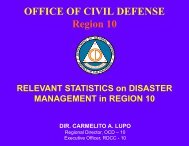Accumulation of Mercury and Other Heavy Metals in Some ... - NSCB
Accumulation of Mercury and Other Heavy Metals in Some ... - NSCB
Accumulation of Mercury and Other Heavy Metals in Some ... - NSCB
Create successful ePaper yourself
Turn your PDF publications into a flip-book with our unique Google optimized e-Paper software.
shells were transferred to separate vials <strong>and</strong> kept frozen. A total <strong>of</strong> 570specimens were gathered <strong>in</strong> the area belong<strong>in</strong>g to six orders <strong>and</strong> ten families.Sediment samples were collected between 0.5 m <strong>and</strong> 1.5 m water depthwith a 52 mm diameter (height = 13 mm) plastic Petri dish. These were filledcompletely <strong>and</strong> tightly sealed with adhesive tape to avoid air spaces. Fivereplicates were gathered for each station <strong>and</strong> kept frozen.To determ<strong>in</strong>e Suspended Particulate Matter (SPM), filters were preweighed<strong>and</strong> a known volume <strong>of</strong> seawater was filtered. Filters were dried at a 110°C oven for a total <strong>of</strong> 3 hours <strong>and</strong> then transferred to a desiccator before tak<strong>in</strong>gthe f<strong>in</strong>al weight. Samples were kept frozen (Hamilton, 1989; Hershelman et al.,1981; Hornung et al., 1981; Joiris et al., 1995; Parker <strong>and</strong> Curtis, 1997) from thetime <strong>of</strong> collection <strong>in</strong> the Philipp<strong>in</strong>es. Water, suspended particles, sediment <strong>and</strong>tissue samples were transferred to a cooler (Igloo) packed with dry ice(O’Connor, 1998) <strong>and</strong> transported to Belgium for analysis.V. Analytical MethodsDissolved organic carbon content <strong>in</strong> filtered seawater were measuredus<strong>in</strong>g a Shimadzu 5000 TOC analyzer while particulate <strong>and</strong> sediment organiccarbon were measured us<strong>in</strong>g the Coulomat carbon analyzer (Coulomat 702-LI,Strohle<strong>in</strong> Labortechnik).For sediments, particle size distribution were determ<strong>in</strong>ed with the use <strong>of</strong> aMastersizer particle analyzer (Mastersizer, Malvern Instruments).An Inductively Coupled Plasma Mass Spectrometer ICP-MS, UltraMass700 (Varian Australia Pty Ltd) was used for metal analysis <strong>in</strong> the differentcompartments: water, organisms <strong>and</strong> sediments.VI.Results <strong>and</strong> DiscussionA. Relationship between metal concentrations <strong>in</strong> the s<strong>of</strong>t tissues <strong>of</strong>organisms <strong>and</strong> concentrations <strong>in</strong> water, suspended particles <strong>and</strong>sediments.Metal concentrations <strong>in</strong> body tissues <strong>of</strong> mollusk <strong>in</strong> the bay were related tometal levels found <strong>in</strong> the three environmental compartments (water, suspendedparticles <strong>and</strong> sediments). Two approaches were applied: (i) simple l<strong>in</strong>earregressions were constructed between metal concentrations <strong>in</strong> the tissues <strong>and</strong>concentrations <strong>in</strong> either water suspended particles or sediments. Theseregressions were performed for four species (T. fenestratus, A. scapha, M.philipp<strong>in</strong>arum <strong>and</strong> Strombidae), which were present at more than three stations.(ii) The second approach was to exam<strong>in</strong>e the relationships further by apply<strong>in</strong>g amulti-l<strong>in</strong>ear regression model with dissolved, suspended particles <strong>and</strong> sedimentmetal concentrations as variables. The model was first applied to <strong>in</strong>dividualspecies for each element <strong>and</strong> later on all the species comb<strong>in</strong>ed. Both regressionanalyses were performed with the computer s<strong>of</strong>tware STATISTICA 6.0.


